Professor, Teikyo University /
Executive Director, The Mori Memorial Foundation
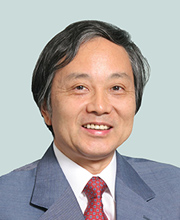

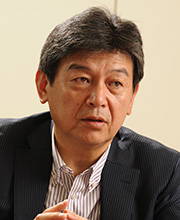
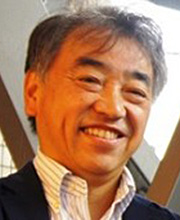

Professor Ito said during the first pre-seminar that Tokyo is transforming into a series of “islands.” Let us hear from the people responsible for this kind of development about what plans they have in store for their respective areas.
The districts of Otemachi, Marunouchi, and Yurakucho have a combined area of roughly 120ha and account for approximately 10% of Chiyoda ward. The streetscape of this area has changed considerably over the past few decades. In 1995 there were still many low-rise buildings, while the Daimaru department store stood as a backdrop to Tokyo Station. 20 years later, Daimaru was lowered, which effectively cleaned up Tokyo Station’s backdrop when viewed from the Imperial Palace. Another major transformation was Naka-dori Avenue, running north-south in the Marunouchi precinct. It was an orderly area but lacked any real appeal around the 1960s, so the street was basically lifeless during the weekend and at daytime on weekdays. The street now, however, is bustling with activity. This change was instigated by the activities of numerous town-planning associations, such as the Council for Area Development and Management of Otemachi, Marunouchi, and Yurakucho, the area management association called Ligare, and the Ecozzeria Association. These association bodies consider intangible ways to improve the area and implement initiatives to bring about change. People’s interest in buildings diminishes after a few years, which of course leads to a downturn in customer footfall, so the objective of area management is to enhance the value of the area, including its new and old aspects. The area is constantly being shepherded in new directions in line with the trends of the times thanks to flexible amendments to guidelines.
Our vision for the Otemachi, Marunouchi, and Yurakucho area is that it will become a place where individuals can thrive, including employees of companies with offices in the area. In other words, by focusing on more innovative working styles, we aim to provide more places and opportunities where people can interact and exchange information, including in shared spaces and on the streets. There are already a number of innovation facilities in the area, notably WeWork, while various startups like TechLab and FINOLAB have also set up business innovation spaces. A new initiative is also gaining momentum with the development divisions of private companies moving into these premises. Rather than just implementing these activities separately, we aim to connect people, build networks, and at the same time improve working styles. We are also stepping up demonstration tests in a number of areas with the goal of deploying AI and IoT systems. The area has a proud history of leading the way for the secondary and tertiary industries in Japan. For this very reason we intend to take the lead in incorporating the necessary technology for the next generation.

When thinking about the identity of the Nihonbashi district and what makes it unique, there are three answers, in my opinion. First, diversity; second, the constant change and challenges; and third and most importantly, the importance placed on human interactions from long ago. Nihonbashi has an image of being a very conservative area, if anything, but it also has a different side. This owes to its historical background. In the Edo period, Nihonbashi was the site of a riverside fish market that originally fulfilled many functions, so ultimately it attracted a wide range of people. This gave rise to the area’s diversity. Moreover, the merchants that gathered there were tolerant of new ideas and challenges. The DNA of those merchants, which takes in changes and challenges, still lives on today. In recent times, the area is working to nurture new industries such as life sciences. For the merchants, because Nihonbashi was such a tough place to do business, there existed a spirit of cooperation and a sense of sophistication that was welcoming of newcomers. This legacy continues even today. This is why we have engaged in the development of the area for the past 20 years or so based on the concept of “creating while retaining and reviving.”
Since the opening of COREDO Muromachi 2 and 3 in 2014, Mitsui Fudosan has engaged in urban redevelopment based on the following four keywords: industry creation; neighborhood creation; community cohesion; and revival of water features. For industry creation, for example, because a multitude of chemists operated next to each other during the Edo period, the major pharmaceutical firms have established their head offices in the area. Drawing on this historical background, we intend to turn Nihonbashi into an innovation hub, centering on the increasingly important life science industry. An association known as LINK-J that was established two years ago hosts networking events of all sizes, as well as innovation events to facilitate cooperation between private, government, and academic institutions. LINK-J is contributing to a wave of innovation and has actually generated some success stories, including some venture firms securing investment funding from large companies, and members winning various awards.
The Nihonbashi area is actually quite broad, measuring approximately 270ha. It consists of towns such as Ningyocho, Bakurocho, and Hamacho which have their own unique characteristics, and the local people in these areas share the same thoughts and feelings about Nihonbashi. We are pushing ahead with development together with the local residents and searching for ways to provide all the functions the community needs as a whole. As I have already mentioned, Nihonbashi retains its sense of community and activity from long ago, with frequent festivals and events taking place all with deep roots to the community. By tidying up the local shrines and open spaces we are facilitating interaction between people in the community and those from surrounding regions and securing community spaces where new added value can be generated. We intend to keep on developing Nihonbashi based on the core ideals of diversity, ambition, and human interaction. Nihonbashi may create the impression of having too high a threshold, but once you set foot inside, there is nowhere else more comforting. I think our job as a developer is to certainly lower this threshold.
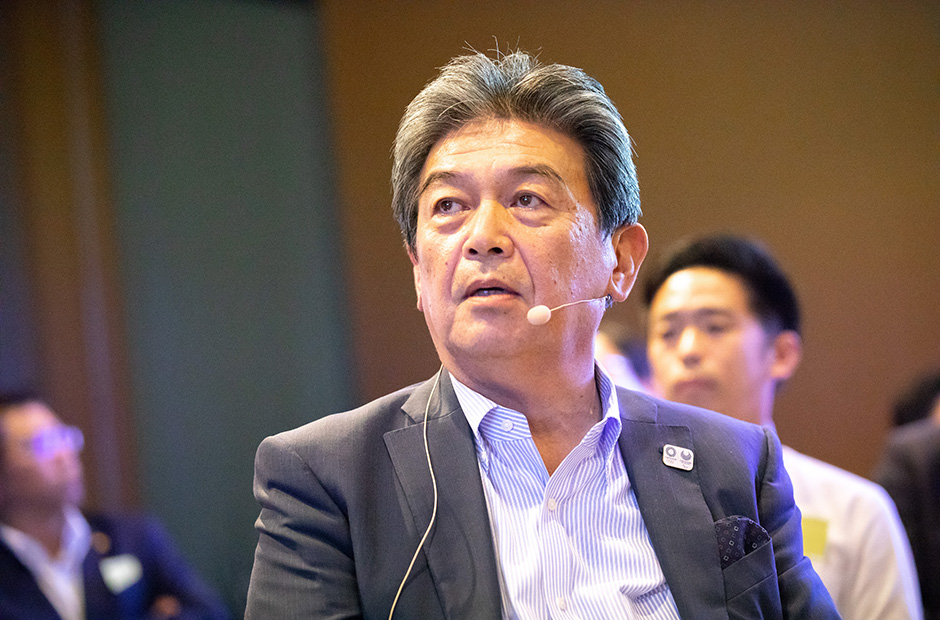
Looking at the history of greater Shibuya, the area within a 2.5km radius extending out from Shibuya Station, the Tokyu Toyoko Line was opened in 1934. The area then underwent considerable change in 1964 when, in the wake of The Olympic Games, NHK (Japan Broadcasting Corporation) moved its offices there. In the 1960s, Shibuya was still a place people living along the train line visited on their day off. From around that time Shibuya came to be known as a trendy area among the younger generation. The Shibuya of today is home to many IT firms and startup businesses, while buildings like QFRONT double as enormous media-transmitting billboards. In recent years, Shibuya and Harajuku have seen a dramatic increase in the number of tourists from overseas. As a railway operator, Tokyu does more than just develop Shibuya Station. We keep in mind how a global Shibuya should be shaped and in particular we try to enliven the whole area through entertainment. Shibuya’s current transformation was set in motion by the Obuchi administration’s emergency economic package in 1998. That also gave birth to plans for Tokyo’s newest subway route, the Fukutoshin Line. Various discussions were subsequently held with respect to the user-friendliness of the Toyoko Line’s infrastructure and stations, leading to their gradual redevelopment. As an example, as part of a land reallocation project participated in by the Urban Renaissance Agency (UR), we plan to restore the rivers that were covered over with culverts due to railroad construction in the past.
Going forward, we will continue to construct buildings in the area, which all started with Shibuya Hikarie, built on the site of the former Tokyu Bunka Kaikan complex. This multi-purpose facility boasts commercial space, offices, theaters, and event halls, and also provides public spaces through which people can “vertically” access the multi-layered Shibuya Station. The so-called “urban core” mechanism within its walls is contributing to the development of one of Tokyo’s special districts designated for regeneration. Shibuya Hikarie also houses the musical theater Orb, thereby ranking it alongside the Bunkamura concert hall as one of Shibuya’s best entertainment facilities. In addition, we plan to complete both the Shibuya Stream and Scramble Square buildings. The former, which will open its doors on September 13, is equipped with offices, shops, hotels, and halls. Google Japan will be moving its head office into this building. And as opposed to secluding it from the rest of the city, we are aiming for the commercial space to be open to the city of Shibuya. In conjunction with these developments, we are also cleaning up the Shibuya River. In September we expect to finish the multi-purpose east tower of Shibuya Station, complete with offices, commercial space, and an observation deck. For this complex, we have plans to team up with five universities (Tokyo University, Tokyo Institute of Technology, Waseda University, Keio University, and Tokyo City University) to establish and manage an academic-industrial alliance workspace. In the Daikanyama district too, a number of development projects are gaining traction. They include LOG ROAD, CAST, 100BANCH, and Cherry Garden. An essential factor in these development projects is area management. A Shibuya Station area management council was created for the purpose of utilizing public spaces and developing a framework to improve the local community through cooperation between the public and private sectors.
Through its development projects, Tokyu Corporation, as a railway operator, aims to create a new core identity while valuing interaction with people that live alongside the tracks and collaborating with all landowners. There are areas in cities that have different identities, like City and West End in London, or Wall Street and Times Square in New York. We hope to nurture a variety of identities in Tokyo that have roots in the railways.

The Mori Building Company undertakes many projects in Minato ward, which encompasses the Roppongi and Toranomon districts. Minato ward is characterized by being very cosmopolitan, having ample business and lifestyle support services, and exhibiting a rich natural environment and many historical resources. Minato ward’s features can be traced back roughly 160 years to the Edo period when large plots of land in Toranomon and Roppongi were dotted with samurai residences. The outline of today’s city emerged around 120 years ago during the Meiji period. Western-style buildings started to appear in place of the samurai residences in Toranomon and Roppongi and smaller plots of land became prominent. By the late 1950s when Tokyo Tower went up, many small offices had appeared around Toranomon, while Roppongi had become a thriving entertainment district attracting many young people and overseas visitors. Topographically, Minato ward is situated between low-lying and hilly areas, while from a population density point of view, it falls between workers and residents.
At Mori Building, we are committed to urban development that leverages the characteristics unique to Minato ward. Beginning with the 1959 construction of the Nishi-Shimbashi 2 Mori Building, which was leased out as office space, we have since undertaken multiple construction projects, including ARK Hills, Atago Green Hills, ARK Hills Sengokuyama Mori Tower, Roppongi Hills, and Toranomon Hills. Mori Building’s urban development vision is for the creation of a functional and compact city teeming with greenery. From an idealistic viewpoint, we aim to realize compact urban development by ensuring an abundance of green spaces above ground and a multitude of services under ground in close proximity to people’s homes and offices. We are employing our “Vertical Garden City” concept as one method for achieving this goal—Roppongi Hills is a classic example of this approach.
Future projects include the development of the west side of Roppongi 5-chome district, the hilly precinct of Toranomon/Azabu, and the Toranomon area centering on Toranomon Hills. Given that Roppongi has made its presence felt as a center of culture, we plan to shape the Roppongi 5-chome district into a new hub of international culture to complement the existing so-called art triangle formed by Tokyo Midtown, the National Art Center, and Roppongi Hills. In the hilly precinct of Toranomon and Azabu, we have set our sights on undertaking a new kind of development focusing on lifestyle and culture by building a super high-rise in the middle of a lush green park equipped with various amenities. And in the area around Toranomon Hills we plan to construct three large buildings and a new Hibiya Line subway station underneath Sakurada-dori Avenue. Considering that Toranomon is situated halfway between Marunouchi, where you can find some of Tokyo’s most-talented personnel, and Shibuya, where so many venture firms are concentrated, we have plans to establish an innovation center and transform the area into a focal point for new business. Based on a global business center concept, the area will likely see the creation of new offices, homes, hotels, bus terminals directly connected to stations, and facilities equipped with residential services. By aptly linking up each area, namely Roppongi Hills (culture), ARK Hills (lifestyle), and Toranomon Hills (business), we also intend to connect Marunouchi, Nihonbashi, and Shibuya and shoulder the burden of development that will enhance Tokyo’s overall appeal.
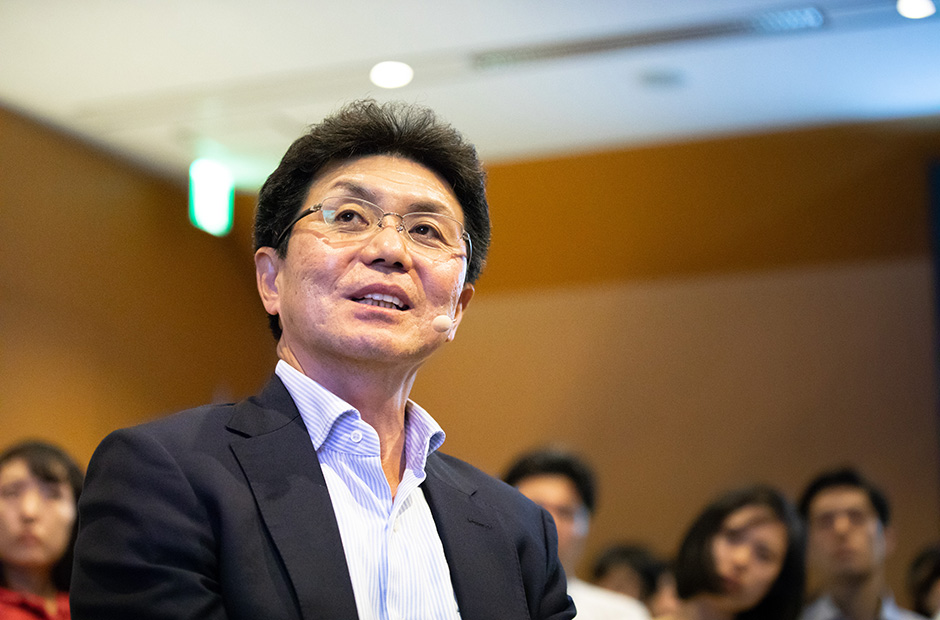
I think collaboration between these different areas will flourish up ahead. In light of this, we need to be mindful of what must be done to enhance Tokyo’s overall identity and appeal. Although I assume the given conditions of each area must differ, one question I have for you is whether or not what is being planned for other areas is taken into consideration when you are formulating your own development plans?
Each area is certainly being developed with respect to its unique characteristics, but in terms of functionality, they are starting to resemble one another. I think a common base for these kinds of development is evolving because we are constantly aware of what is happening in other areas.
Given that your respective companies are establishing innovation facilities, what do you think you have to do to differentiate yourselves?
We are more concerned with attracting companies rather than individuals because Marunouchi is an office area where few workers live nearby. The important thing here is who you can potentially meet. Our idea is to combine offices and people in order to attract innovative minds.
People are more closely connected than ever before due to the spread of social media, but are events that connect people and bring them together important for developers?
Importance has always been placed on face-to-face interactions, and I think social media is just a new way of communicating. Only recently a crowdfunding event was held in Marunouchi and independently organized by the promoter. The area will likely be invigorated by these kinds of spontaneous events occurring regularly.
People have tastes and preferences for different areas, with some liking Roppongi and others Shibuya, but do developers adopt a mindset to target new people and companies regardless of such attributes?
We first come up with ideas on how to harness the resources unique to an area. Accordingly, we do not refuse anybody. By utilizing the resources of the area in a number of ways, I think we gradually create characteristics that only exist in that area.
At present, each area has different attributes, but before long these elements will come to overlap, so as developers, do you think you will cooperate with each other?
Right now, Mitsubishi Estate and Mitsui Fudosan are hosting an excursion campaign. With the participation of Daimaru and Takashimaya department stores, as well as JR East railway, the idea is to let patrons go on a shopping tour in Marunouchi, Nihonbashi, and Ningyocho. We are also thinking about the use of a shuttle bus. I think we will see more of these types of events in the future.
Is there anything we can learn from cities overseas to make Tokyo more appealing?
We can see from the results of the Mori Memorial Foundation’s annual Global Power City Index that the gap between London in first place and Tokyo in third owes to cultural factors and factors related to airport access. I think we need to bear in mind these weaknesses when engaging in urban development.
Some people are of the opinion that we must create more characteristic cityscapes in order to further enhance Tokyo’s appeal. What do you think about landscaping?
Construction is not easy because of the strict regulations, but thinking of the relationship between the shape of our road network and landscape, Shibuya certainly exhibits some notable landmarks due to its many forked roads. Stations closely resemble one another so they need to exude more uniqueness. Plus, we need to focus more on adding greenery.

In Nihonbashi there are plenty of historical buildings constructed during the Meiji and Taisho periods, such as the Bank of Japan, Mitsui Honkan, Mitsukoshi, and Takashimaya. These are tourist resources and must be preserved as part of the city’s landscape. We are currently receiving support from other companies to introduce a concept known as the “hyaku-shaku line”, or the 31-meter line, which has its roots in the old restrictions on building height, thereby creating unity between new and old buildings.
The tone of the landscape in Marunouchi, particularly in front of the Imperial Palace, needs to be harmoniously balanced with the buildings in the area. In addition to voluntarily establishing guidelines on our own initiative, local councils on landscaping have also participated in the process. In 2027 a building close to 400m in height will be built, which will likely have a considerable impact on the well-organized scenery of Marunouchi. However, in addition to the impact on the skyline, we are getting creative with above-ground and below-ground sections of buildings. For example, when we reconstructed buildings that face the palace moat, we installed underground equipment to clean the water in the moat. I think we must come up with various schemes for the Marunouchi area as a whole.
The land developed by Mori Building is unlike that of the other three developers in that there are elevation differences, and in most cases the sites do not face major roads and are asymmetric because we need to consult the local residents. That is why we apply our Vertical Garden City concept to create a type of compact city with many open spaces and lots of greenery above ground. At Mori Building, our developments take into consideration the impact super high-rises and ground-level constructions have on the overall area.
Tokyo has many great districts but the methods of transportation that connect them are congested. Are there any solutions and approaches to counteract this?
Looking ahead, work-style reforms and other initiatives should bring about changes, and a decrease in the number of people starting work at 9am will naturally ease the congestion. On the other hand, 10 years ago there was concern that train passengers were in decline, but that has actually never transpired, partially due to the impact of overseas visitors.
What we do require going forward is urban development aimed at foreign visitors to Japan. What kind of things can we do in this regard?
We are putting infrastructure in place, including multilingual support. That said, if we make everything too much like other countries, Tokyo may no longer hold much appeal for foreign visitors. We intend to make adjustments based on observing what works best, in order to decide how much we should align with global standards and how much we should retain truly Japanese elements.
If the level of each area has increased after 2025 when most developments will have been completed, I believe Tokyo will survive as a result of the value created. I would like to hear your thoughts about this.
While people’s working styles will probably change, we must strike the right balance by, for example, transforming Tokyo into a fun and entertaining city. My biggest concern lies with coworking. There is some potential for this working style to gain traction, though I think larger companies will struggle to collaborate with other firms due to information management issues.
My comment relates to business rather than inbound tourism. If there is not enough capital circulating in the domestic economy, Tokyo’s appeal will wane and attracting investment from abroad will prove difficult. And if economic activity is concentrated solely in Tokyo, other regions will decline, resulting in little interest in Japan as a country. In other words, it is vital that we maintain the appeal of Japan’s regions and communicate as much from Tokyo. Collaborative projects and businesses between Tokyo and regional areas are ongoing at places like the 3x3 Lab Future in Otemachi, Marunouchi, and Yurakucho. Looking ahead, it is these kinds of initiatives that will continue to increase, I think.
Each developer is currently utilizing special zones and floor area premiums to undertake development projects, but areas in which they can do so are limited. As Mr. Inoue has said, we must highlight the appeal of regional areas and do so from Tokyo.
As already mentioned, working styles will change in the coming years and I think the line between work and home will gradually fade. But even during those times, people will still long for a good environment and relaxation. Culture and education will be everlasting. In an abstract sense, no matter how far technology progresses, Tokyo needs places where people can relax.
My final question for you all: can you describe the identity of your area in Tokyo?
Minato ward is a compact city where homes and offices are in close proximity.
Shibuya is chaotic but we are gradually fixing that.
Nihonbashi has hardiness inherited from the merchants of the Edo period.
Marunouchi has harmony and tolerance, the extreme opposite to Shibuya.